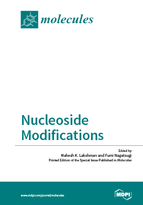Nucleoside Modifications
A special issue of Molecules (ISSN 1420-3049). This special issue belongs to the section "Molecular Diversity".
Deadline for manuscript submissions: closed (31 March 2015) | Viewed by 99342
Special Issue Editors
Interests: nucleoside modification via metal-catalyzed and uncatalyzed processes; synthesis of novel nucleoside structures; chemical carcinogenesis; site-specific DNA modification; synthesis of polycyclic aromatic hydrocarbons and their metabolites; aryne chemistry; generally applicable synthetic methodology
Interests: oligonucleotides; artificial molecules for binding to DNA and RNA; selective chemical reactions to DNA and RNA
Special Issue Information
Dear Colleagues,
Nucleosides are the fundamental components of genetic material, and are present in all living organisms, and in viruses. By virtue of their ubiquity, they are highly important biomolecules. Nucleosides consist of a heterocyclic aglycone and a sugar unit. For several decades, the natural nucleoside structures have inspired the development of chemical and biochemical modifications, leading to new nucleoside-like entities via aglycone, as well as saccharide, modifications. As a result, modified nucleosides and nucleoside analogues have wide spread utilities in biochemistry, biology, as pharmaceutical agents, and as biological probes. There is a constant need for access to novel nucleoside analogues for a plethora of applications, prompting the development of new methodologies. This Special Issue aims to provide a forum for the dissemination of the latest information on new chemical methods for access to modified nucleosides, nucleoside analogues, and applications of these new molecules.
Professor Mahesh K. Lakshman
Professor Fumi Nagatsugi
Guest Editors
Manuscript Submission Information
Manuscripts should be submitted online at www.mdpi.com by registering and logging in to this website. Once you are registered, click here to go to the submission form. Manuscripts can be submitted until the deadline. All submissions that pass pre-check are peer-reviewed. Accepted papers will be published continuously in the journal (as soon as accepted) and will be listed together on the special issue website. Research articles, review articles as well as short communications are invited. For planned papers, a title and short abstract (about 100 words) can be sent to the Editorial Office for announcement on this website.
Submitted manuscripts should not have been published previously, nor be under consideration for publication elsewhere (except conference proceedings papers). All manuscripts are thoroughly refereed through a single-blind peer-review process. A guide for authors and other relevant information for submission of manuscripts is available on the Instructions for Authors page. Molecules is an international peer-reviewed open access semimonthly journal published by MDPI.
Please visit the Instructions for Authors page before submitting a manuscript. The Article Processing Charge (APC) for publication in this open access journal is 2700 CHF (Swiss Francs). Submitted papers should be well formatted and use good English. Authors may use MDPI's English editing service prior to publication or during author revisions.







